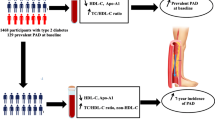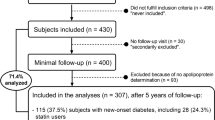Abstract
An earlier study showed that fasting and postprandial concentrations of apolipoprotein B48 were raised in patients with type 2 diabetes (DM2) and peripheral arterial disease (PAD) as compared with persons without DM2 or persons with DM2 but not PAD. The aim of this study was to confirm the association of PAD and B48 in a larger group of patients with DM2 and the relation of B48 with the preheparin lipoprotein lipase (LPL) mass. We studied 456 patients with DM2. PAD was defined as an ankle-brachial index (ABI) <0.9. Apolipoprotein B48 was quantified by ELISA. Apo B48 was significantly higher in the group with an ABI <0.9 than the groups with ABI of 0.9–1.3 and >1.3 (10.7 ± 6.28 vs. 9.24 ± 5.5 vs. 9.17 ± 8.8 mg/L, ANOVA test, p < 0.05). B48 was independently associated with an ABI <0.9 (OR 1.053; 95 % CI, 1.013–1.094; p < 0.05), together with smoking and duration of diabetes. The preheparin LPL mass was similar in the patients with and without PAD. In conclusion, we confirmed that fasting B48 is an independent marker of PAD in patients with DM2, unrelated to the preheparin LPL mass, statin therapy or glucose lowering treatment.

Similar content being viewed by others
References
Jude EB, Eleftheriadou I, Tentolouris N (2010) Peripheral arterial disease in diabetes—a review. Diabet Med 27:4–14
Gæde P, Lund-Andersen H, Parving H-H, Pedersen O (2008) Effect of a multifactorial intervention on mortality in type 2 diabetes. N Engl J Med 358:580–591
Fogelstrand P, Borén J (2012) Retention of atherogenic lipoproteins in the artery wall and its role in atherogenesis. Nutr Metab Cardiovasc Dis 22:1–7
Stalenhoef AF, de Graaf J (2008) Association of fasting and nonfasting serum triglycerides with cardiovascular disease and the role of remnant-like lipoproteins and small dense LDL. Curr Opin Lipidol 19:355–361
Valdivielso P, Hidalgo A, Rioja J, Aguilar I, Ariza MJ, Gonzalez-Alegre T, Gonzalez-Santos P (2007) Smoking and postprandial triglycerides are associated with vascular disease in patients with type 2 diabetes. Atherosclerosis 194:391–396
Valdivielso P, Puerta S, Rioja J et al (2010) Postprandial apolipoprotein B48 is associated with asymptomatic peripheral arterial disease: a study in patients with type 2 diabetes and controls. Clin Chim Acta 411:433–437
Wang H, Eckel RH (2009) Lipoprotein lipase: from gene to obesity. Am J Physiol Endocrinol Metab 297:E271–E288
Olivecrona T, Olivecrona G (2000) Determination and clinical significance of lipoprotein lipase and hepatic lipase. In: Rifai N, Warnick G, Dominiczak M (eds) Handbook of lipoprotein testing. AACC Press, Washington, pp 479–498
Vilella E, Joven J, Fernández M, Vilaró S, Brunzell JD, Olivecrona T, Bengtsson-Olivecrona G (1993) Lipoprotein lipase in human plasma is mainly inactive and associated with cholesterol-rich lipoproteins. J Lipid Res 34:1555–1564
Kobayashi J, Saito K, Fukamachi I, Taira K, Takahashi K, Bujo H, Saito Y (2001) Pre-heparin plasma lipoprotein lipase mass: correlation with intra-abdominal visceral fat accumulation. Horm Metab Res 33:412–416
Zambon A, Schmidt I, Beisiegel U, Brunzell JD (1996) Dimeric lipoprotein lipase is bound to triglyceride-rich plasma lipoproteins. J Lipid Res 37:2394–2404
Ranganathan G, Unal R, Pokrovskaya ID, Tripathi P, Rotter JI, Goodarzi MO, Kern PA (2011) The lipoprotein lipase (LPL) S447X gain of function variant involves increased mRNA translation. Atherosclerosis 221:143–147
Potier L, Halbron M, Bouilloud F et al (2009) Ankle-to-brachial ratio index underestimates the prevalence of peripheral occlusive disease in diabetic patients at high risk for arterial disease. Diabetes Care 32:e44
Leng GC, Fowkes FG (1992) The Edinburgh Claudication Questionnaire: an improved version of the WHO/Rose Questionnaire for use in epidemiological surveys. J Clin Epidemiol 45:1101–1109
Ariza MJ, Sanchez-Chaparro MA, Baron FJ et al (2010) Additive effects of LPL, APOA5 and APOE variant combinations on triglyceride levels and hypertriglyceridemia: results of the ICARIA genetic sub-study. BMC Med Genet 11:66
Sato I, Ishikawa Y, Ishimoto A et al (2009) Significance of measuring serum concentrations of remnant lipoproteins and apolipoprotein B-48 in fasting period. J Atheroscler Thromb 16:12–20
Sakai N, Uchida Y, Ohashi K et al (2003) Measurement of fasting serum apoB-48 levels in normolipidemic and hyperlipidemic subjects by ELISA. J Lipid Res 44:1256–1262
Lapice E, Cipriano P, Patti L, Romano G, Vaccaro O, Rivellese A (2012) Fasting APO B48 levels are associated with microalbuminuria in patients with type 2 diabetes. Acta Diabetol. doi:10.1007/s00592-012-0386-1
Hayashi T, Hirano T, Taira T, Tokuno A, Mori Y, Koba S, Adachi M (2008) Remarkable increase of apolipoprotein B48 level in diabetic patients with end-stage renal disease. Atherosclerosis 197:154–158
Tanimura K, Nakajima Y, Nagao M et al (2008) Association of serum apolipoprotein B48 level with the presence of carotid plaque in type 2 diabetes mellitus. Diabetes Res Clin Pract 81:338–344
Alipour A, Valdivielso P, Elte JWF et al. (2011) Exploring the value of apoB48 as marker for atherosclerosis in clinical practice. Eur J Clin Invest 42:702–708
Rizza S, Cardellini M, Martelli E et al (2010) Occult impaired glucose regulation in patients with atherosclerosis is associated to the number of affected vascular districts and inflammation. Atherosclerosis 212:316–320
Lopez-Miranda J, Williams C, Lairon D (2007) Dietary, physiological, genetic and pathological influences on postprandial lipid metabolism. Br J Nutr 98:458–473
Reyes-Soffer G, Holleran S, Karmally W et al (2009) Measures of postprandial lipoproteins are not associated with coronary artery disease in patients with type 2 diabetes mellitus. J Lipid Res 50:1901–1909
Werner C, Filmer A, Fritshc M, Groenewald S, Gräber S, Böhm M, Laufs U (2011) The Homburg Cream and Sugar Study (HCS)
Tomkin GH, Owens D (2012) The chylomicron: relationship to atherosclerosis. Int J Vasc Med 2012:784536
Kobayashi J, Nohara A, Kawashiri MA, Inazu A, Koizumi J, Nakajima K, Mabuchi H (2007) Serum lipoprotein lipase mass: clinical significance of its measurement. Clin Chim Acta 378:7–12
Hanyu O, Miida T, Kosuge K et al (2007) Preheparin lipoprotein lipase mass is a practical marker of insulin resistance in ambulatory type 2 diabetic patients treated with oral hypoglycemic agents. Clin Chim Acta 384:118–123
Kobayashi J, Nakajima K, Nohara A et al. (2007) The relationship of serum lipoprotein lipase mass with fasting serum apolipoprotein B-48 and remnant-like particle triglycerides in type 2 diabetic patients. Horm Metab Res 39:612–616
Nierman MC, Rip J, Kuivenhoven J-A et al (2005) Carriers of the frequent lipoprotein lipase S447X variant exhibit enhanced postprandial apoprotein B-48 clearance. Metab, Clin Exp 54:1499–1503
Tornvall P, Olivecrona G, Karpe F, Hamsten A, Olivecrona T (1995) Lipoprotein lipase mass and activity in plasma and their increase after heparin are separate parameters with different relations to plasma lipoproteins. Arterioscler Thromb Vasc Biol 15:1086–1093
Wållberg-Jonsson S, Dahlén G, Johnson O, Olivecrona G, Rantapää-Dahlqvist S (1996) Lipoprotein lipase in relation to inflammatory activity in rheumatoid arthritis. J Intern Med 240:373–380
Tan GD, Olivecrona G, Vidal H, Frayn KN, Karpe F (2006) Insulin sensitisation affects lipoprotein lipase transport in type 2 diabetes: role of adipose tissue and skeletal muscle in response to rosiglitazone. Diabetologia 49:2412–2418
Saiki A, Oyama T, Endo K et al (2007) Preheparin serum lipoprotein lipase mass might be a biomarker of metabolic syndrome. Diabetes Res Clin Pract 76:93–101
Acknowledgments
The authors would like to express their gratitude to all the participants, to Ian Johnstone for help translating the manuscript, to Ana Hornos for her technical support at CIMES and to Solveig Nilsson, Department of Medical Biosciences, Umeå University for running the LPL ELISA. The study was supported by a grant from the Sociedad Española de Arteriosclerosis/Fundación Española de Arteriosclerosis 2/2009 (JM), by a grant to Grupo Consolidado CTS 159 of the Junta de Andalucía (MASC, PGS, PVF), and by the Swedish Heart and Lung Foundation (GO).
Conflict of interest
None declared.
Author information
Authors and Affiliations
Corresponding author
Additional information
Communicated by Renato Lauro.
Rights and permissions
About this article
Cite this article
Mancera-Romero, J., Sánchez-Chaparro, M.A., Rioja, J. et al. Fasting apolipoprotein B48 is a marker for peripheral arterial disease in type 2 diabetes. Acta Diabetol 50, 383–389 (2013). https://doi.org/10.1007/s00592-012-0434-x
Received:
Accepted:
Published:
Issue Date:
DOI: https://doi.org/10.1007/s00592-012-0434-x




